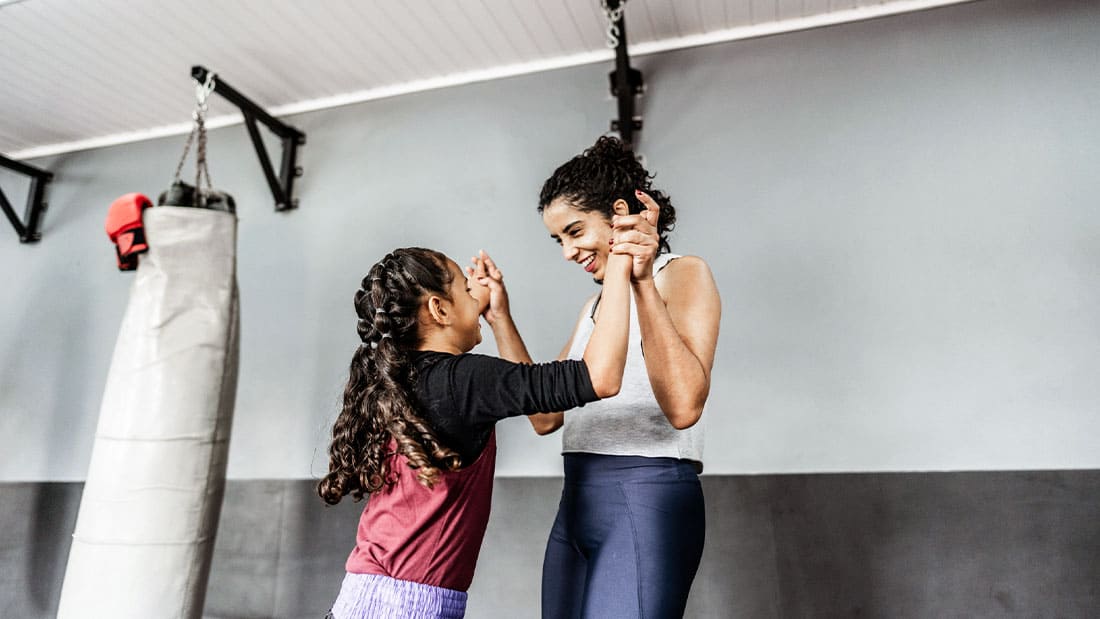Build Explosive Strength with This Olympic Weightlifting Program
Olympic lifts are used in many strength and conditioning programs to develop explosive power and triple extension. Although they can greatly increase power production, the technical complexity of the lifts require proper progression for mastery.
Fortunately, variations of the lifts can be used to safely and effectively progress to full versions of the Clean and Jerk and the Snatch.
This Olympic weightlifting program lists sequences of appropriate progressions, which you can follow to become a more explosive athlete in a short amount of time.
Clean and Jerk
In the Clean and Jerk, the athlete first lifts the bar from the ground up to the front of the shoulders, then jerks the barbell overhead. The most common variations for strength and conditioning programs are the Power Clean and Hang Power Clean. They are also great progressions to learn the full lifts due to their reduced range of motion over the full Clean.
Clean and Jerk Progression
Front Squat
[youtube video=”y66Q-vj13fo” /]The Front Squat forms the foundation for the receiving position of the Clean. Therefore, the Front Squat is the first exercise used in this progression for the Clean.
RDL
[youtube video=”1gsVNstGI8M” /]
Once an athlete has mastered the Front Squat, he or she should learn the RDL or Romanian Deadlift. The RDL is a basic hip hinge pattern that teaches an athlete to effectively load the hamstrings. This exercise closely mimics the lowering phase of the Hang Clean.
Hang Power Clean
[youtube video=”GKDYk3wuWwk” /]
This is the first variation of the Clean, which an athlete should learn after mastering the Front Squat and RDL. Lower the bar to just below the knee, like in the RDL. Immediately change directions and clean the bar by explosively extending your hips, knees and ankles. This triple extension should be followed immediately by pulling the bar into the front rack position. Note that a Block Power Clean can also be used in place of the Hang if an athlete has access to blocks.
Hang Power Clean + Front Squat
[youtube video=”yEWJIDoMVGI” /]
Once an athlete has mastered the Hang Power Clean, add a Front Squat after the Clean to bridge the gap to a full Clean. Ideally, your feet should not have to move between the Hang Power Clean and Front Squat. Adding in a Front Squat after the Clean is a great way to prevent landing with excessively wide feet after a Clean.
Power Clean
[youtube video=”qvpUpH37mJs” /]
Now it’s time to move down to the floor. This position requires more mobility than the Hang or Blocks. Make sure you have the mobility required to pull from the floor with a neutral spine. Push with your legs off the floor while keeping a constant torso angle until the bar reaches your knee. From there, the Clean is identical to a Hang Clean.
Power Clean + Front Squat
[youtube video=”2J4b8XTVHoY” /]
Once an athlete has comfortably learned the full Power Clean, he or she can add in a Front Squat, as with the previous progressions.
Clean
[youtube video=”jhAdb9Fl934″ /]
This is the final progression of the Clean. The first phase is the same as the Power Clean. The only difference is that the Power Clean receiving position is above parallel, while the full Clean receiving position is below parallel.
Push Press
[youtube video=”iJ0LTLyr_Cs” /]
The Push Press forms the foundation for the Jerk. It teaches a proper dip and drive while ensuring an athlete has adequate shoulder mobility to safely go overhead. Starting in the front rack position, the athlete “dips” by performing a quarter squat, then explosively changes direction during the “drive” phase by extending the hips and knees until the barbell is safely overhead.
Power Jerk
[youtube video=”zRIT53XwLww” /]
The dip and drive phase of the Power Jerk is identical to the Push Press,but instead of fully extending the hips and knees and driving up, the athlete immediately rebends the hip and knees and pushes him- or herself under the barbell.
Press from Split
[youtube video=”3otC67kefQ0″ /]
The next progression is to find an athlete’s proper split position. One way is to have a coach gently push the athlete forward and see which foot he or she uses to catch him- or herself. From there, the athlete can find the proper split position by keeping their feet around shoulder-width apart and keeping their knees at a 90-degree angle. Once in this position, they can press the bar overhead.
Jerk from Split
[youtube video=”C9ej1aSm5pQ” /]
The athlete should start in the split position, then jerk the bar overhead by re-bending their knees after the dip and drive phase.
Split Jerk
[youtube video=”nJLU1TR1kSQ” /]
The final progression in the jerk sequence. The athelte transitions immediately from the dip and drive into the split position while receiving the barbell overhead.
Now the athlete is ready to put it all together. Clean the bar, get a breath or two, and jerk it overhead!
Snatch
The Snatch progression is nearly identical to the Clean progression. The only difference is that the bar ends up overhead rather than on the shoulders. Just as the foundation of the Clean is the Front Squat, the foundation of the snatch is the Overhead Squat.
Overhead Squat
[youtube video=”N8TmMG9GnTg” /]
First, have the athlete find his or her ideal grip-width by placing the barbell in their hip crease and flexing their knee to 90 degrees. Ideally, the barbell should not have to move when the hip is at 90 degrees. Press the barbell overhead and squat with a neutral spine until the hips are below parallel.
Hang Power Snatch
[youtube video=”X0JkLsBfLhI” /]
The athlete begins with the bar in their hip crease, knees slightly bent and shoulders vertical. Hinge or RDL down to just below the knee, then explosively change directions and extend the hips and knees while pulling the barbell overhead. Re-bend the knees and receive the barbell overhead above parallel.
Hang Power Snatch + Overhead Squat
[youtube video=”oQQGsfMkjvY” /]
The athlete performs the Hang Power Snatch as before, but performs an Overhead Squat afterwards to work on mobility and finding a proper receiving position. Once again, you can use blocks if available.
Power Snatch
[youtube video=”8fAZ9W2pyOA” /]
The Power Snatch from the floor is appropriate once the athlete has sufficient mobility to snatch from the floor with a neutral spine. The torso angle should remain constant from the floor to the knees until the barbell passes the knees, at which point the movement becomes similar to the Hang Power Snatch.
Power Snatch + OHS
[youtube video=”PxsuM_2sUSQ” /]
The athlete perform a Power Snatch immediately followed by an Overhead Squat. Over time, the athlete should learn to keep the same foot position for both exercises.
Snatch
[youtube video=”Pf31XSZ9KlE” /]This is the real thing. The athlete performs a Snatch by receiving the barbell with his or her hips below parallel instead of above parallel in the Power Snatch.
[cf]skyword_tracking_tag[/cf]RECOMMENDED FOR YOU
MOST POPULAR
Build Explosive Strength with This Olympic Weightlifting Program
Olympic lifts are used in many strength and conditioning programs to develop explosive power and triple extension. Although they can greatly increase power production, the technical complexity of the lifts require proper progression for mastery.
Fortunately, variations of the lifts can be used to safely and effectively progress to full versions of the Clean and Jerk and the Snatch.
This Olympic weightlifting program lists sequences of appropriate progressions, which you can follow to become a more explosive athlete in a short amount of time.
Clean and Jerk
In the Clean and Jerk, the athlete first lifts the bar from the ground up to the front of the shoulders, then jerks the barbell overhead. The most common variations for strength and conditioning programs are the Power Clean and Hang Power Clean. They are also great progressions to learn the full lifts due to their reduced range of motion over the full Clean.
Clean and Jerk Progression
Front Squat
[youtube video=”y66Q-vj13fo” /]The Front Squat forms the foundation for the receiving position of the Clean. Therefore, the Front Squat is the first exercise used in this progression for the Clean.
RDL
[youtube video=”1gsVNstGI8M” /]
Once an athlete has mastered the Front Squat, he or she should learn the RDL or Romanian Deadlift. The RDL is a basic hip hinge pattern that teaches an athlete to effectively load the hamstrings. This exercise closely mimics the lowering phase of the Hang Clean.
Hang Power Clean
[youtube video=”GKDYk3wuWwk” /]
This is the first variation of the Clean, which an athlete should learn after mastering the Front Squat and RDL. Lower the bar to just below the knee, like in the RDL. Immediately change directions and clean the bar by explosively extending your hips, knees and ankles. This triple extension should be followed immediately by pulling the bar into the front rack position. Note that a Block Power Clean can also be used in place of the Hang if an athlete has access to blocks.
Hang Power Clean + Front Squat
[youtube video=”yEWJIDoMVGI” /]
Once an athlete has mastered the Hang Power Clean, add a Front Squat after the Clean to bridge the gap to a full Clean. Ideally, your feet should not have to move between the Hang Power Clean and Front Squat. Adding in a Front Squat after the Clean is a great way to prevent landing with excessively wide feet after a Clean.
Power Clean
[youtube video=”qvpUpH37mJs” /]
Now it’s time to move down to the floor. This position requires more mobility than the Hang or Blocks. Make sure you have the mobility required to pull from the floor with a neutral spine. Push with your legs off the floor while keeping a constant torso angle until the bar reaches your knee. From there, the Clean is identical to a Hang Clean.
Power Clean + Front Squat
[youtube video=”2J4b8XTVHoY” /]
Once an athlete has comfortably learned the full Power Clean, he or she can add in a Front Squat, as with the previous progressions.
Clean
[youtube video=”jhAdb9Fl934″ /]
This is the final progression of the Clean. The first phase is the same as the Power Clean. The only difference is that the Power Clean receiving position is above parallel, while the full Clean receiving position is below parallel.
Push Press
[youtube video=”iJ0LTLyr_Cs” /]
The Push Press forms the foundation for the Jerk. It teaches a proper dip and drive while ensuring an athlete has adequate shoulder mobility to safely go overhead. Starting in the front rack position, the athlete “dips” by performing a quarter squat, then explosively changes direction during the “drive” phase by extending the hips and knees until the barbell is safely overhead.
Power Jerk
[youtube video=”zRIT53XwLww” /]
The dip and drive phase of the Power Jerk is identical to the Push Press,but instead of fully extending the hips and knees and driving up, the athlete immediately rebends the hip and knees and pushes him- or herself under the barbell.
Press from Split
[youtube video=”3otC67kefQ0″ /]
The next progression is to find an athlete’s proper split position. One way is to have a coach gently push the athlete forward and see which foot he or she uses to catch him- or herself. From there, the athlete can find the proper split position by keeping their feet around shoulder-width apart and keeping their knees at a 90-degree angle. Once in this position, they can press the bar overhead.
Jerk from Split
[youtube video=”C9ej1aSm5pQ” /]
The athlete should start in the split position, then jerk the bar overhead by re-bending their knees after the dip and drive phase.
Split Jerk
[youtube video=”nJLU1TR1kSQ” /]
The final progression in the jerk sequence. The athelte transitions immediately from the dip and drive into the split position while receiving the barbell overhead.
Now the athlete is ready to put it all together. Clean the bar, get a breath or two, and jerk it overhead!
Snatch
The Snatch progression is nearly identical to the Clean progression. The only difference is that the bar ends up overhead rather than on the shoulders. Just as the foundation of the Clean is the Front Squat, the foundation of the snatch is the Overhead Squat.
Overhead Squat
[youtube video=”N8TmMG9GnTg” /]
First, have the athlete find his or her ideal grip-width by placing the barbell in their hip crease and flexing their knee to 90 degrees. Ideally, the barbell should not have to move when the hip is at 90 degrees. Press the barbell overhead and squat with a neutral spine until the hips are below parallel.
Hang Power Snatch
[youtube video=”X0JkLsBfLhI” /]
The athlete begins with the bar in their hip crease, knees slightly bent and shoulders vertical. Hinge or RDL down to just below the knee, then explosively change directions and extend the hips and knees while pulling the barbell overhead. Re-bend the knees and receive the barbell overhead above parallel.
Hang Power Snatch + Overhead Squat
[youtube video=”oQQGsfMkjvY” /]
The athlete performs the Hang Power Snatch as before, but performs an Overhead Squat afterwards to work on mobility and finding a proper receiving position. Once again, you can use blocks if available.
Power Snatch
[youtube video=”8fAZ9W2pyOA” /]
The Power Snatch from the floor is appropriate once the athlete has sufficient mobility to snatch from the floor with a neutral spine. The torso angle should remain constant from the floor to the knees until the barbell passes the knees, at which point the movement becomes similar to the Hang Power Snatch.
Power Snatch + OHS
[youtube video=”PxsuM_2sUSQ” /]
The athlete perform a Power Snatch immediately followed by an Overhead Squat. Over time, the athlete should learn to keep the same foot position for both exercises.
Snatch
[youtube video=”Pf31XSZ9KlE” /]This is the real thing. The athlete performs a Snatch by receiving the barbell with his or her hips below parallel instead of above parallel in the Power Snatch.
[cf]skyword_tracking_tag[/cf]









